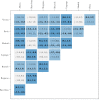Multilevel Bayesian analysis of monk parakeet contact calls shows dialects between European cities
- PMID: 38193012
- PMCID: PMC10773303
- DOI: 10.1093/beheco/arad093
Multilevel Bayesian analysis of monk parakeet contact calls shows dialects between European cities
Abstract
Geographic differences in vocalizations provide strong evidence for animal culture, with patterns likely arising from generations of social learning and transmission. Most studies on the evolution of avian vocal variation have predominantly focused on fixed repertoire, territorial song in passerine birds. The study of vocal communication in open-ended learners and in contexts where vocalizations serve other functions is therefore necessary for a more comprehensive understanding of vocal dialect evolution. Parrots are open-ended vocal production learners that use vocalizations for social contact and coordination. Geographic variation in parrot vocalizations typically take the form of either distinct regional variations known as dialects or graded variation based on geographic distance known as clinal variation. In this study, we recorded monk parakeets (Myiopsitta monachus) across multiple spatial scales (i.e., parks and cities) in their European invasive range. We then compared calls using a multilevel Bayesian model and sensitivity analysis, with this novel approach allowing us to explicitly compare vocalizations at multiple spatial scales. We found support for founder effects and/or cultural drift at the city level, consistent with passive cultural processes leading to large-scale dialect differences. We did not find a strong signal for dialect or clinal differences between parks within cities, suggesting that birds did not actively converge on a group level signal, as expected under the group membership hypothesis. We demonstrate the robustness of our findings and offer an explanation that unifies the results of prior monk parakeet vocalization studies.
Keywords: Bayesian statistics; communication; culture; dialects; monk parakeet; open-ended vocal learning.
© The Author(s) 2023. Published by Oxford University Press on behalf of the International Society for Behavioral Ecology.
Conflict of interest statement
All authors declare to have no competing interests.
Figures





References
-
- Aplin LM. 2019. Culture and cultural evolution in birds: a review of the evidence. Anim Behav. 147:179–187.
-
- Arellano CM, Canelón NV, Delgado S, Berg KS.. 2022. Allo-preening is linked to vocal signature development in a wild parrot. Behav Ecol. 33(1):202–212.
-
- Baker AJ, Jenkins PF.. 1987. Founder effect and cultural evolution of songs in an isolated population of chaffinches, Fringilla coelebs, in the Chatham Islands. Anim Behav. 35(6):1793–1803.
-
- Baker MC. 2003. Local similarity and geographic differences in a contact call of the Galah (Cacatua roseicapilla assimilis) in Western Australia. Emu 103(3):233–237.
-
- Balsby Thorsten JS, Bradbury JW.. 2009. Vocal matching by orange-fronted conures (Aratinga canicularis). Behav Process. 82(2):133–139. - PubMed
LinkOut - more resources
Full Text Sources

